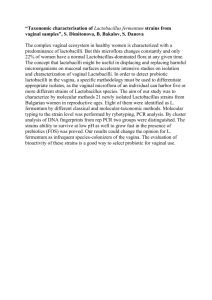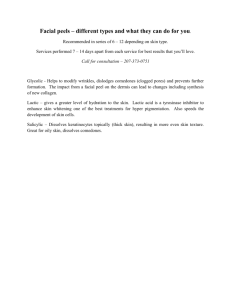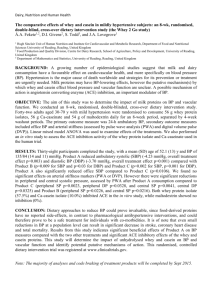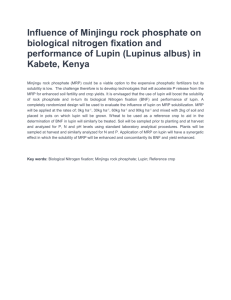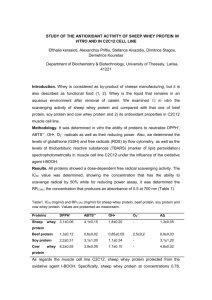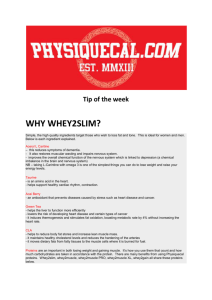Advance Journal of Food Science and Technology 9(9): 679-685, 2015
advertisement
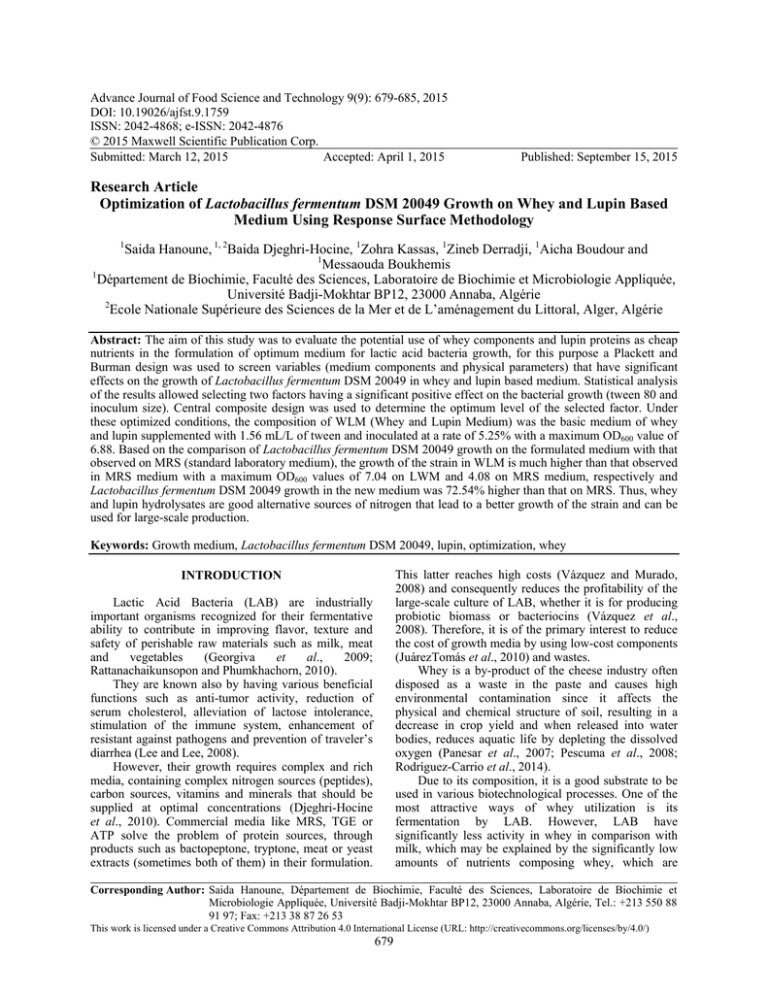
Advance Journal of Food Science and Technology 9(9): 679-685, 2015 DOI: 10.19026/ajfst.9.1759 ISSN: 2042-4868; e-ISSN: 2042-4876 © 2015 Maxwell Scientific Publication Corp. Submitted: March 12, 2015 Accepted: April 1, 2015 Published: September 15, 2015 Research Article Optimization of Lactobacillus fermentum DSM 20049 Growth on Whey and Lupin Based Medium Using Response Surface Methodology 1 Saida Hanoune, 1, 2Baida Djeghri-Hocine, 1Zohra Kassas, 1Zineb Derradji, 1Aicha Boudour and 1 Messaouda Boukhemis 1 Département de Biochimie, Faculté des Sciences, Laboratoire de Biochimie et Microbiologie Appliquée, Université Badji-Mokhtar BP12, 23000 Annaba, Algérie 2 Ecole Nationale Supérieure des Sciences de la Mer et de L’aménagement du Littoral, Alger, Algérie Abstract: The aim of this study was to evaluate the potential use of whey components and lupin proteins as cheap nutrients in the formulation of optimum medium for lactic acid bacteria growth, for this purpose a Plackett and Burman design was used to screen variables (medium components and physical parameters) that have significant effects on the growth of Lactobacillus fermentum DSM 20049 in whey and lupin based medium. Statistical analysis of the results allowed selecting two factors having a significant positive effect on the bacterial growth (tween 80 and inoculum size). Central composite design was used to determine the optimum level of the selected factor. Under these optimized conditions, the composition of WLM (Whey and Lupin Medium) was the basic medium of whey and lupin supplemented with 1.56 mL/L of tween and inoculated at a rate of 5.25% with a maximum OD600 value of 6.88. Based on the comparison of Lactobacillus fermentum DSM 20049 growth on the formulated medium with that observed on MRS (standard laboratory medium), the growth of the strain in WLM is much higher than that observed in MRS medium with a maximum OD600 values of 7.04 on LWM and 4.08 on MRS medium, respectively and Lactobacillus fermentum DSM 20049 growth in the new medium was 72.54% higher than that on MRS. Thus, whey and lupin hydrolysates are good alternative sources of nitrogen that lead to a better growth of the strain and can be used for large-scale production. Keywords: Growth medium, Lactobacillus fermentum DSM 20049, lupin, optimization, whey This latter reaches high costs (Vázquez and Murado, 2008) and consequently reduces the profitability of the large-scale culture of LAB, whether it is for producing probiotic biomass or bacteriocins (Vázquez et al., 2008). Therefore, it is of the primary interest to reduce the cost of growth media by using low-cost components (JuárezTomás et al., 2010) and wastes. Whey is a by-product of the cheese industry often disposed as a waste in the paste and causes high environmental contamination since it affects the physical and chemical structure of soil, resulting in a decrease in crop yield and when released into water bodies, reduces aquatic life by depleting the dissolved oxygen (Panesar et al., 2007; Pescuma et al., 2008; Rodríguez-Carrio et al., 2014). Due to its composition, it is a good substrate to be used in various biotechnological processes. One of the most attractive ways of whey utilization is its fermentation by LAB. However, LAB have significantly less activity in whey in comparison with milk, which may be explained by the significantly low amounts of nutrients composing whey, which are INTRODUCTION Lactic Acid Bacteria (LAB) are industrially important organisms recognized for their fermentative ability to contribute in improving flavor, texture and safety of perishable raw materials such as milk, meat and vegetables (Georgiva et al., 2009; Rattanachaikunsopon and Phumkhachorn, 2010). They are known also by having various beneficial functions such as anti-tumor activity, reduction of serum cholesterol, alleviation of lactose intolerance, stimulation of the immune system, enhancement of resistant against pathogens and prevention of traveler’s diarrhea (Lee and Lee, 2008). However, their growth requires complex and rich media, containing complex nitrogen sources (peptides), carbon sources, vitamins and minerals that should be supplied at optimal concentrations (Djeghri-Hocine et al., 2010). Commercial media like MRS, TGE or ATP solve the problem of protein sources, through products such as bactopeptone, tryptone, meat or yeast extracts (sometimes both of them) in their formulation. Corresponding Author: Saida Hanoune, Département de Biochimie, Faculté des Sciences, Laboratoire de Biochimie et Microbiologie Appliquée, Université Badji-Mokhtar BP12, 23000 Annaba, Algérie, Tel.: +213 550 88 91 97; Fax: +213 38 87 26 53 This work is licensed under a Creative Commons Attribution 4.0 International License (URL: http://creativecommons.org/licenses/by/4.0/) 679 Adv. J. Food Sci. Technol., 9(9): 679-685, 2015 necessary for the growth of LAB that require highly nutritionally rich medium (Bulatović et al., 2014). Lupin is an economically and agriculturally valuable plant that grows in different soils and climates. It is cultivated as a ruminant feed, as a green manure contributing to improve soil structure and has a strong capacity to fix nitrogen. It is also used for human nutrition due to its high protein and oil contents (Dervas et al., 1999; Erbas et al., 2005; Gulewicz et al., 2008). The aims of this study are the following: To evaluate the potential use of whey components and lupin proteins as cheaper nutrients in the formulation of optimum medium for the LAB growth and lactic acid production to reduce media cost. To optimize the physical and nutritional parameters for the growth of a Lactobacillus fermentum DSM 20049 strain using Plackett and Burman Design (PBD) and Central Composite Design (CCD). To compare the growth of Lactobacillus fermentum DSM 20049 on medium formulated with their observed on MRS (standard laboratory medium). MATERIALS AND METHODS Microorganism and culture conditions: Lactobacillus fermentum DSM 20049 was used in this study: strain of the collection was provided kindly as freeze dried from DSMZ laboratory by Pr. Amrane. A. The strain was maintained at 4°C and sub-cultured monthly on MRS medium agar slants. Inoculum preparation: The inoculum was prepared by transferring one colony into 10 mL of MRS broth Pronadisa, Conda S.A., Spain) and incubated for 16 h at 37°C. The culture adjusted to an OD600 of 0.60 was used to inoculate growth media. Basic medium of lupin and whey preparation: Lupin Whey Protein Extracts (LWPE) preparation: Sixty gram of lupin flour was added into 1000 mL of whey powder reconstituted at 6% (w/v) corresponding to 34 g/L of lactose before use. The resulting slurry was magnetically stirred for 20 min after adjusting the initial pH to 9 in order to solubilize lupin proteins, constituted essentially by globulins which are insoluble in water at the Isoelectric Point (pI). Most of lupin proteins (8595%) are soluble at pH 9.0 (Chango et al., 1995). The mixture was centrifuged at 4000 rpm for 20 min at room temperature and the resulting supernatant rich en lupin proteins and lactose was adjusted to pH 6.0 for further enzymatic hydrolysis. Enzymatic hydrolysis: The supernatant hydrolysis was carried out at 55°C with horizontal shaking at 100 rpm for 24 h after the addition of 50 µg of papain into the resulting supernatant. The mixture was heated at 100°C for 20 min to make the enzyme inactivated. After that, the mixture was centrifuged at 4000 rpm for 20 min and Table 1: Levels of variable medium ingredients and physical parameters used in PBD High level Low level Factors Symbol (+1) (-1) Yeast extract (g/L) X1 5.00 0.0 Meat extract (g/L) X2 4.00 0.0 Sodium acetate (g/L) X3 5.00 0.0 Tri-ammonium citrate (g/L) X4 2.00 0.0 MgSO4.7H2O (g/L) X5 0.20 0.0 MnSO4.4H2O (g/L) X6 0.05 0.0 Na2HPO4.12H2O (g/L) X7 1.00 0.1 Tween 80 (g/L) X8 1.00 0.0 Agitation (rpm) X9 120 0.0 Inoculum size (%) X10 5.00 2.0 pH X11 6.50 5.5 the resulting supernatant has been used as a basic medium of lupin and whey. Screening of the nutrients and physical parameters using plackett-burman design and statistical analysis of data: Plackett-Burman Design (PBD) was used to screen variables (medium components and physical parameters) that have significant effects on Lactobacillus fermentum DSM 20049 growth (Plackett and Burman, 1946). A set of 12 experiments (k+1) was carried out for 11 factors (k = 11), each variable was represented at two levels: high (+1) and low concentration (-1). Among the factors: Yeast extract (X1), meat extract (X2), sodium acetate (X3), tri-ammonium citrate (X4), MgSO4.7H2O (X5), MnSO4.4H2O (X6), Na2HPO4. 12H2O (X7), tween 80 (X8), Agitation (X9), inoculum size (X10) and pH (X11) were used. All nutrients were added to basic medium of lupin and whey after sterilization at 121°C for 15 min with 2 concentrations (Table 1). MINITAB 16 trial version was used for the regression analysis of the experimental data obtained (Table 2). Statistical analysis of the response was performed and represented in Table 3. The significance of each variable was determined via Student’s t-test and the level of significance was given as p-value≤0.3. Central Composite Designs (CCD): The Central Composite Design (CCD) was used as a second experiment to determine the optimum level and the interaction between the significant variables with a positive effect on the growth of Lactobacillus fermentum DSM 20049. Based on the results of PBD, inoculum size (X1) and tween 80 (X2) were selected for further optimization using CCD. For this purpose, a 22 full factorial design was carried out with five replicates at the center points leading to a matrix of CCD design consisted of 13 experimental runs. Each factor was studied at five experimental levels (-1, 41, -1, 0, +1 and 1, 41) (Table 4 and 5). 680 Adv. J. Food Sci. Technol., 9(9): 679-685, 2015 Table 2: Proximate composition of lupin whey hydrolysate Protein (%) Powder whey 21.10 Lupin 33.56 Lupin Whey Hudrolysate (LWH) 53.42 Assays were carried out in triplicate Total sugar (%) / / 31.65 Lactose (%) 56.66 / / Table 3: Plackett-Burman design of variables (in coded levels) with optical density values as response Factors ----------------------------------------------------------------------------------------------------------------------------------------------------Run X1 X2 X3 X4 X5 X6 X7 X8 X9 X10 X11 order 1 +1 +1 -1 +1 +1 +1 -1 -1 -1 +1 -1 2 -1 +1 +1 -1 +1 +1 +1 -1 -1 -1 +1 3 +1 -1 +1 +1 -1 +1 +1 +1 -1 -1 -1 4 -1 +1 -1 +1 +1 -1 +1 +1 +1 -1 -1 5 -1 -1 +1 -1 +1 +1 -1 +1 +1 +1 -1 6 -1 -1 -1 +1 -1 +1 +1 -1 +1 +1 +1 7 +1 -1 -1 -1 +1 -1 +1 +1 -1 +1 +1 8 +1 +1 -1 -1 -1 +1 -1 +1 +1 -1 +1 9 +1 +1 +1 -1 -1 -1 +1 -1 +1 +1 -1 10 -1 +1 +1 +1 -1 -1 -1 +1 -1 +1 +1 11 +1 -1 +1 +1 +1 -1 -1 -1 +1 -1 +1 12 -1 -1 -1 -1 -1 -1 -1 -1 -1 -1 -1 +1: Higher level; -1: Lower level Table 4: Statistical analysis of Plackett-Burman design results Term Coef. Constant 4.2633 Yeast extract 0.1067 Meat extract 0.1300 Sodium acetate 0.4302 Tri-ammonium citrate 0.0433 MgSO4.7H2O -0.1602 MnSO4.4H2O -0.0033 Na2HPO4.12H2O -1.5612 Tween 80 0.1867 Agitation -2.8667 Inoculum size 0.2633 pH -0.0333 R2 = 99.40%; R2 (adj) = 98.00%; S.E.: Standard error Table 5: Central composite design results Run order X1 X2 1 6.0000 1.0000 2 6.0000 2.0000 3 4.5000 1.5000 4 4.5000 1.5000 5 4.5000 2.2071 6 3.0000 2.0000 7 2.3786 1.5000 8 4.5000 0.7928 9 4.5000 1.5000 10 3.0000 1.0000 11 6.6213 1.5000 12 4.5000 1.5000 13 4.5000 1.5000 OD (600 nm) 5.92 5.92 6.24 6.16 5.60 4.72 4.40 5.04 6.20 5.04 5.84 6.32 6.30 MINITAB 16 trial version was used for multiple regression analysis and Design Expert version 9.0.3.1 (STAT-EASE Inc., Minneapolis, MN, USA) was used for the generation of surface plot and 3D-contour plots. Analytical methods: Measurement of growth: Cell growth measurement was determined spectrophotometrically by measuring absorbance at 600 nm after appropriate dilution to keep the absorbance values of fermented samples previously incubated at 37°C for 24 h below 0.6 and the resulting S.E. coef. 0.1244 0.1244 0.1244 0.8883 0.1244 0.8883 0.1244 0.9140 0.1244 0.1244 0.1244 0.1244 t-value 34.28 0.86 1.05 0.48 0.35 -0.18 -0.03 -1.71 1.50 -23.05 2.12 -0.27 Ash (%) / / 4 OD values 7.36 6.98 7.26 1.44 1.78 1.06 7.50 1.12 1.86 7.60 1.12 6.08 p-value 0.000 0.454 0.373 0.641 0.751 0.861 0.980 0.126 0.230 0.000 0.125 0.806 absorbance value was multiplied by the corresponding dilution factor to achieve the final OD600 value. Growth kinetics of Lactobacillus fermentum DSM 20049: The growth curves were monitored by measuring the optical density OD600 every 1 h until it reaches the stationary phase. Both of MRS and WLP media were inoculated at a rate of 5.25% and incubated at 37°C for 24 h in the same conditions. Determination of medium composition: Proteins were determined according to the method of Lowry et al. (1951). The amount of total sugars was measured by the phenol-sulfuric reaction (Dubois et al., 1956), with glucose as standard. Dry matter % was measured after drying samples at 105°C to a constant weight and ash percentage was calculated by reweighting samples after subsequent 5 h incubation at 550°C. RESULTS Screening of significant variables using PBD: The examination of the data listed in Table 3 has shown a 681 Adv. J. Food Sci. Technol., 9(9): 679-685, 2015 large variation in the growth of Lactobacillus fermentum DSM 20049 in the 12 trials from 1.06 to 7, which proves the importance of using the PBD and CCD to optimize the conditions (nutrients and physical parameters) required by the strain to improve its growth. Analysis of the regression coefficients and the tvalues of 11 factors: The obtained data showed the significance of 4 factors: Agitation, inoculum size, Na2HPO4.12H2O and tween 80 with p-values corresponding to 0.00, 0.125, 0.126 and 0.23, respectively (Table 4). Agitation was determined to be the most significant, but with a negative coefficient. In the six trials without agitation, the bacterial population reached only an OD600nm between (1.06-1.44) units whereas (6.08-7.6) units were detected in the 6 other trials with agitation. Therefore, the agitation showed stronger inhibitor effect for Lactobacillus fermentum DSM 20049 growth. This result is consistent with previous searches showing that the agitation may be unfavorable for LAB growth; this is especially the case of Streptococcus thermophilus (Louaileche et al., 1993). Na2HPO4.12H2O was also exhibited to have a negative effect as the whey contains a concentration of sodium (Wong et al., 1978) that can exceed the requirement of the strain. The inoculum size was found to be significant with a positive effect. Thus, it was selected for further optimization using CCD to determine the optimum level of initial active biomass to obtain a better growth of the organism. Tween 80 was also found to be significant but with a positive effect since it is composed of a mixture of oleic esters. It is a source of fatty acids essential for the growth of these bacteria and it was also selected for further optimization. All other seven factors (yeast extract, meat extract, sodium acetate, tri-ammonium citrate, MgSO4.7H2O, MnSO4.4H2O and pH were found to be insignificant; therefore they will be excluded in further experiments. Central Composite Design (CCD): As expected, based on the results of PBD, inoculum size (X1) and tween 80 (X2) were selected to determine the optimum level of each factor for a bacterial growth improvement. Inoculum size was used at a range of 2.37-6.62% and tween 80 at 0.79-2.2 mL/L. The significance of each coefficient was determined by Student’s t-test and p-values. The design matrix of tested variables and the experimental results are shown in Table 5 and 6. The coefficient of determination (R2) was calculated as 0.9537 indicating good agreement Table 6: Analysis of variance of the central composite design Term Coef. S.E. coef. t Constant -3.1626 1.24148 -2.547 X1 2.2510 0.33742 6.671 X2 4.6420 1.01226 4.586 -0.2298 0.03104 -7.403 X1*X1 X2*X2 -1.6680 0.27935 -5.971 0.1228 0.12280 0.869 X1*X2 R2 = 95.37%; R2 (adj) = 92.07%; S.E.: Standard error p 0.038 0.000 0.003 0.000 0.001 0.414 between experimental observation and predicted values (Xu et al., 2008) and thus, the model can explain 95.37% of the variability in the response. Only 4.63% of the total variation cannot be explained by the model. The value of the adjusted determination coefficient (R2adj = 0.9207) was high enough to indicate the significance of the model (Papagora et al., 2013). Both factors (inoculums size and tween 80) were found to be significant with a positive coefficient with p-values of 0.000 and 0.003 respectively. However, their interaction was insignificant. The 3D plot and their respective 2D contour (Fig. 1) provide a visual interpretation for the interaction between the two factors selected and thus allow determining the optimum levels of each variable for maximum growth of Lactobacillus fermentum DSM 20049. It is clear from its well form (convex form) that ranges of levels were well chosen. The examination of the contour and three dimensional plots showed an increase of the growth as the inoculum size increased up to 5.25% and the tween 80 reached a concentration of 1.56 mL/L. A maximum growth of Lactobacillus fermentum DSM 20049 (OD600 = 6.32) can be obtained by combining the optimum levels of inoculum size and tween 80 given as 5.25% and 1.56 mL/L, respectively. A decrease of the growth was observed when the levels exceed these given optimum ones. Validation of the model: Validation of the model was carried out in 180 mL flask containing 30 mL of medium composed of basic medium of whey and lupin supplemented with 1.56 mL/L of tween inoculated at a rate of 5.25% and incubated at 37° for 24 h. Under these optimized conditions, the predicted response for bacterial growth was 6.37 (data not shown) and the mean of the observed growth was 6.88. The good agreement between the predicted and the experimental values confirmed the validity of the model and their high degree of similarity indicated that the response surface methodology was a powerful optimization tool. Growth kinetics of Lactobacillus fermentum DSM 20049: In order to compare the bacterial growth in the elaborated medium with that in MRS, two curves were drawn with a vertical axis representing OD600 values and an horizontal axis representing the elapsed time in hours (Fig. 2). 682 Adv. J. Food Sci. Technol., 9(9): 679-685, 2015 Fig. 1: Three-dimensional response surface plots for Lactobacillus fermentum DSM 20049 growth showing the interactive effects of tween 80 and inoculum size Fig. 2: Growth curves of Lacoctobacillus fermentum DSM 20049 on WLM and MRS medium It has been noted that the bacterial growth follows a classic pattern of a batch culture. The growth of the strain on WLM is generally much higher than that observed on MRS medium, while the exponential phase was achieved after 5 h on WLM and 8 h on MRS medium and the maximum OD600 values was 7.04 on LWM and 4.08 on MRS medium. Lb. fermentum DSM 20049 growth on LWM medium was 72.54% higher than that on MRS. DISCUSSION Nutritional requirements of LAB are fastidious: Culture media have to be supplemented with various peptide sources and growth factors. Among a variety of these nitrogen sources, yeast extract is the best one due to its high content of nitrogen compounds, abundant purine, pyrimidine bases and vitamins. It can contribute not only to high biomass, but also to high level lactic acid metabolism. However, the cost of yeast extract accounts for about 38% of the total lactic acid production cost and its high cost greatly impairs the economic efficiency of lactic acid fermentation. Consequently, it is important to find cheap nitrogen source alternatives (Amrane, 2000; Liu et al., 2010). For this purpose, several low-cost alternative nitrogen sources have been tested to partially or totally replace yeast extract in order to stimulate the growth of probiotic and lactic acid bacteria species and to improve the amount of the produced lactic acid. Among the previous works that dealt with this subject, Hujanen and Linko (1996) used corn steep liquor, malt sprout extract and casein hydrolysates to replace the costly yeast extract. Amrane (2000) evaluated the lactic acid bacteria autolysate for the supplementation of lactic acid bacteria fermentation. Kwon et al. (2000) used soybean supplemented with vitamins for a complete replacement of yeast extract as for Production of lactic acid by Lactobacillus rhamnosus. While Djeghri-Hocine et al. (2006) used the horse bean extract for the supplementation of lactic acid bacteria culture media. Horn et al. (2007) studied the evaluation of different cod viscera fractions as a medium for lactic acid bacteria growth. 683 Adv. J. Food Sci. Technol., 9(9): 679-685, 2015 Djeghri-Hocine et al. (2007a) studied the Growth of lactic acid bacteria on oilseed crop pea-and chickpeabased media and the evaluation of delipidated egg yolk and yeast autolysate as growth supplements for lactic acid bacteria culture (Djeghri-Hocine et al., 2007b). Soares de Castro and Sato (2014) evaluated Soy protein isolate, bovine whey protein and egg white protein hydrolysates to promote the growth of bifidobacteria and lactic acid bacteria strains. In this study, the use of whey and lupin hydrolysates showed a good alternative source of nitrogen leading to a well growth of Lactobacillus fermentum DSM 20049. The whey, rich in protein and lactose, constitutes an excellent source of Carbone and the lupin, composed by 33.56% of proteins provides, after hydrolysis, the amino acid and short peptides required for the growth of the strain (Table 2). Moreover, it contains sugars of the Raffinose Family and Oligosaccharides (RFOs) with prebiotic importance that can improve the growth of some lactic acid bacteria strains (Erbas et al., 2005; Martίnez-Villaluenga and Gómez, 2007). The use of CCD allowed elaborating the final composition medium with an inoculation rate of 5.25% and 1.56 mL/L of tween 80. This result is in agreement with the works of Dong et al. (2014) who showed that the tween 80 had a very significant beneficial effect on the cell growth and the cell concentration was approximately 1.79.109 cfu/mL. Tween 80, which is a water soluble derivative of oleic acid (cis-9octadecenoic acid), can stimulate the growth of many LAB. Most LAB grown in medium containing Tween 80 can incorporate oleic acid into their membranes and then transform it into cyclopropane fatty acids. Cyclopropane fatty acids can act like polyunsaturated fatty acids to increase the fluidity of membrane and protect LAB from bad environmental effects such as deleterious effects of oxygen, entering stationary growth phase and low pH caused by lactic acid accumulation. Consequently, Tween 80, which can also replace the biotin requirement of some strains, is regarded as a growth-stimulating factor for LAB (Hassinen et al., 1951; Partanen et al., 2001; Dong et al., 2014). CONCLUSION This study suggested that the whey and lupin hydrolysates showed a good alternative source of nitrogen leading to a well growth of Lactobacillus fermentum DSM 20049. The supplementation of the basic medium of whey and lupin supplemented with 1.56 mL/L of tween 80 inoculated at a rate of 5.25% showed a growth which is 72.54% higher than that on MRS. thus, whey and lupin can replace expensive sources and used for large-scale production. ACKNOWLEDGMENT This study was financially supported by the laboratory of applied biochemistry and microbiology and the biochemistry department, University of Badji Mokhtar Annaba, Algeria. The authors gratefully acknowledge Pr. A Mechakra-Maza for the scientific support and Pr. A Amrane for the LAB strain. Conflict of interest: The authors declare that they have no conflict of interest. REFERENCES Amrane, A., 2000. Evaluation of lactic acid bacteria autolysate for the supplementation of lactic acid bacteria fermentation. World J. Microb. Biot., 16: 207-209. Bulatović, M.L., B.R. Marica, V.M. Ljiljana, B.N. Svetlana, S.V.S. Maja and P.D.V. Aleksandra, 2014. Improvement of production performance of functional fermented whey based beverage. Chem. Ind. Chem. Eng. Q., 20(1): 1-153. Chango, A., C. Villaume, H.M. Bau and J.P. Nicolas, 1995. Fractionation by thermal coagulationof lupin proteins: Physicochemical characteristics. Food Res. Int., 28: 91-99. Dervas, G., G. Doxastakis, S. Zinoviadi and N. Triandatafillakos, 1999. Lupin flour addition to wheat flour doughs and effect on rhelogical properties. Food Chem., 66: 67-73. Djeghri-Hocine, B., M. Boukhemis, N. Zidoune and A. Amrane, 2006. Horse bean extract for the supplementation of lactic acid bacteria culture media. J. Food Technol., 4(4): 299-302. Djeghri-Hocine, B., M. Boukhemis, N. Zidoune and A. Amrane, 2007a. Growth of lactic acid bacteria on oilseed crop pea- and chickpea-based media. World J. Microb. Biot., 23(6): 765-769. Djeghri-Hocine, B., M. Boukhemis, N. Zidoune and A. Amrane, 2007b. Evaluation of de-lipidated egg yolk and yeast autolysate as growth supplements for lactic acid bacteria culture. Int. J. Dairy Technol., 60(4): 292-296. Djeghri-Hocine, B., M. Boukhemis and A. Amrane, 2010. Formulation and Evaluation of a selective medium for lactic acid bacteria-validation on some dairy products. Am. J. Agr. Biol. Sci., 5(2): 184-153. Dong, Z., L. Lei Gu, J. Zhang, M. Miao Wang, G. Du, J. Chen and H. Li, 2014. Optimisation for high cell density cultivation of Lactobacillus salivarius BBE 09-18 with response surface methodology. Int. Dairy J., 34: 230-236. Dubois, M., K.A. Gilles, J.K. Hamilton, P.A. Rebers and F. Smith, 1956. Colorimetric method for determination of sugars and related substances. Anal. Chem., 28: 350-356. 684 Adv. J. Food Sci. Technol., 9(9): 679-685, 2015 Erbas, M., M. Certel and M.K. Uslu, 2005. Some chemical properties of white lupin seeds (Lupinus albus L.). Food Chem., 89: 341-345. Georgiva, R., D. Koleva, D. Nikolova, D. Yankov and S. Danova, 2009. Growth parameters of probiotic strain Lactobacillus plantarum, isolated from traditional white cheese. Biotechnol. Biotec. Eq., 23: 861-865. Gulewicz, P., C. Martı´nez-Villaluenga, J. Frias, D. Ciesiołka, K. Gulewicz and C. Vidal-Valverde, 2008. Effect of germination on the protein fraction composition of different lupin seeds. Food Chem., 107: 830-844. Hassinen, J., G. Durbin, R. Tomarelli and F. Bernhart, 1951. The minimal nutritional requirements of Lactobacillus bifidus. J. Bacteriol., 62: 771-777. Horn, S.J., S.I. Aspmo and V.G.H. Eijsink, 2007. Evaluation of different cod viscera fractions and their seasonal variation used in a growth medium for lactic acid bacteria. Enzyme Microb. Tech., 40: 1328-1334. Hujanen, M. and Y.Y. Linko, 1996. Effect of temperature and various nitrogen sources on L (+)lactic acid production by Lactobacillus casei. Appl. Microbiol. Biot., 45: 307-313. JuárezTomás, M.S., E. Bru, B. Wiese and M.E.F. Nader-Macías, 2010. Optimization of lowcost culture media for the production of biomass and bacteriocin by a urogenital Lactobacillus salivarus strain. Probiotic Antimicr. Prot., 2: 2-11. Kwon, S., P.C. Lee, E.G. Lee, Y.K. Chang and N. Chang, 2000. Production of lactic acid by Lactobacillus rhamnosus with vitaminsupplemented soybean hydrolysate. Enzyme Microb. Tech., 26: 209-215. Lee, H.M. and Y. Lee, 2008. A differential medium of lactic acid-producing bacteria in mixed culture. Lett. Appl. Microbiol., 46: 676-681. Liu, B., M. Yang, B. Qia, X. Chena, Z. Sua and Y. Wana, 2010. Optimizing l-(+)-lactic acid production by thermophile Lactobacillus plantarum As.1.3 using alternative nitrogen sources with response surface method. Biochem. Eng. J., 52: 212-219. Louaileche, H., P. Bracquart, F. Saulnier, M. Desmazeaud and G. Linden, 1993. Carbon dioxide effects on the growth and metabolites of morphological variants of Streptococcus thermophilus. J. Dairy Sci., 76: 3683-3689. Lowry, O.H., N.J. Rosebrough, A.L. Farr and R.J. Randall, 1951. Protein measurement with the folin phenol reagent. J. Biol. Chem., 270: 27299-27304. Martίnez-Villaluenga, C. and R. Gómez, 2007. Characterization of bifidobacteria as starters in fermented milk containing raffinose family of oligosaccharides from lupin as prebiotic. Int. Dairy J., 17: 116-122. Panesar, P.S., J.F. Kennedy, D.N. Gandi and K. Bunko, 2007. Bioutilisation of whey for lactic acid production. Food Chem., 105: 1-14. Papagora, C., T. Roukas and P. Kotzekidou, 2013. Optimization of extracellular lipase production by Debaryomyces hansenii isolates from dry-salted olives using response surface methodology. Food Bioprod. Process., 91: 413-420. Partanen, L., N. Marttinen and T. Alatossava, 2001. Fats and fatty acids as growth factors for Lactobacillus delbrueckii. Syst. Appl. Microbiol., 24: 500-506. Pescuma, M., E.M. Hébert, F. Mozzi and G. Fond de Valdez, 2008. Whey fermentation by thermophilic lactic acid bacteria: Evolution of carbohydrates and protein content. Food Microbiol., 25: 442-451. Plackett, R.L. and J.P. Burman, 1946. The design of optimal multifactorial experiments. Biometrika, 33: 305-325. Rattanachaikunsopon, P. and P. Phumkhachorn, 2010. Lactic acid bacteria: Their antimicrobial compounds and their use in food production. Ann. Biol. Res., 1 (4): 218-228. Rodríguez-Carrio, J., A. Fernández, F.A. Riera and A. Sáurez, 2014. Immunomodulatory activities of whey-lactoglobulintryptic-digested fractions. Int. Dairy J., 34: 65-73. Soares de Castro, R.J. and H.H. Sato, 2014. Functional properties and growth promotion of bifidobacteria and lactic acid bacteri astrains by protein hydrolysates using a statistical mixture design. Food Biosci., 7: 19-30. Vázquez, J.A. and M.A. Murado, 2008. Mathematical tools for objective comparison of microbial cultures application to evaluation of 15 peptones for lactic acid bacteria productions. Biochem. Eng. J., 39: 176-287. Vázquez, J.A., S.F. Docasal, M.A. Prieto, M.A. González and M.A. Murado, 2008. Growth and metabolic features of lactic acid bacteria in media with hydrolysed fish viscera. An approach to bio-salige of fishing by-products. Bioresource Technol., 99: 6246-6257. Wong, N.P., D.E. Lacroix and F.E. Mcdounough, 1978. Minerals in whey and whey fractions. J. Dairy Sci., 61: 1700-1703. Xu, H., L. Sun, D. Zhao, B. Zhang, Y. Shi and Y. Wu, 2008. Production of α-amylase by Aspergillus oryzae As-3951 in solidstate fermentation using spent brewing grains as substrate. J. Sci. Food Agr., 88(3): 529-535. 685
